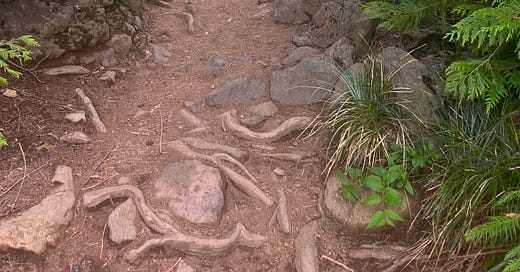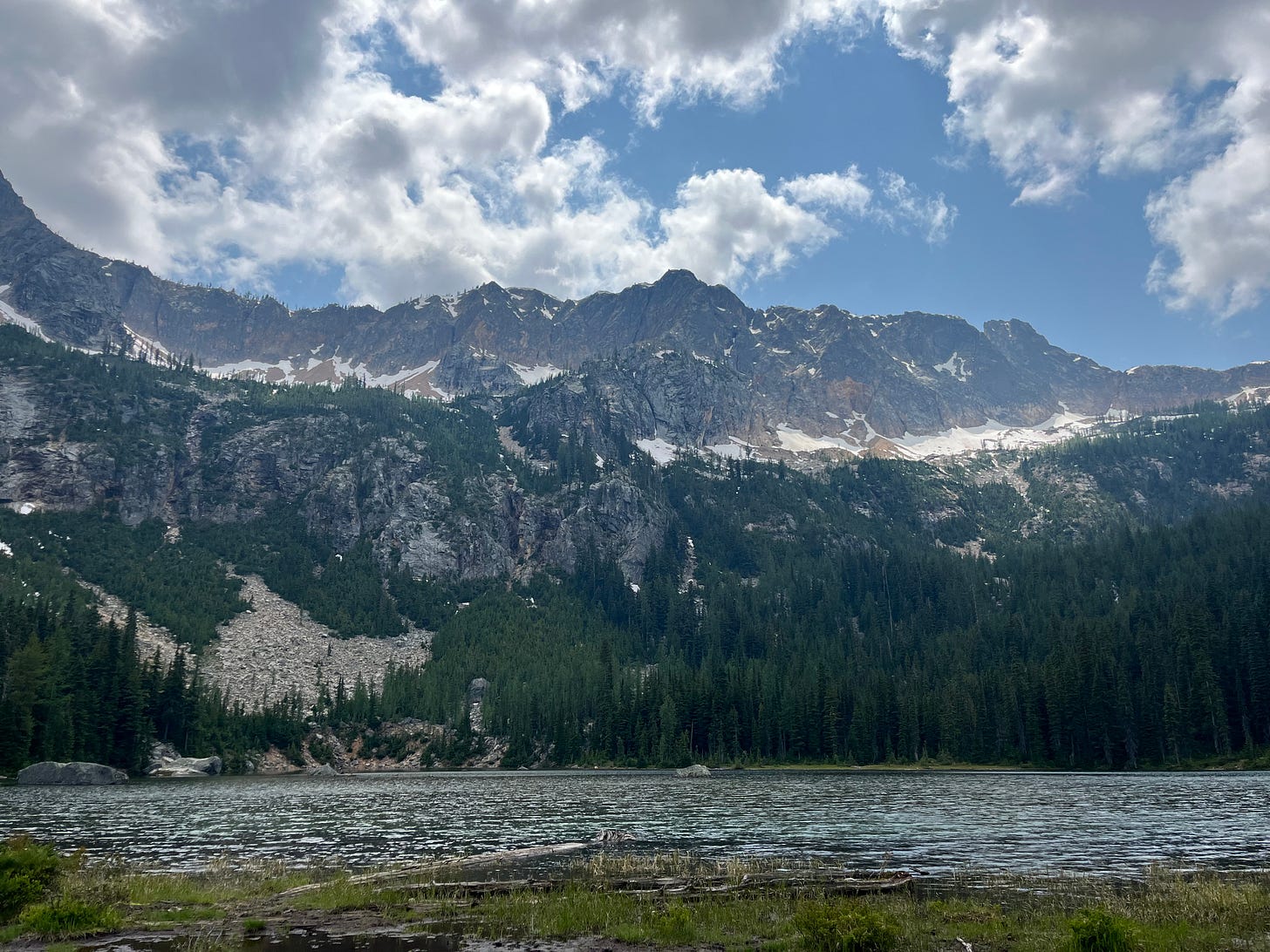I didn’t always hike. In fact, for a long time, despite growing up in the literal woods, I was pretty adamant that I didn’t hike. A friend at the summer theatre where I worked for several summers invited me to go hiking more than once; I told her no over and over again, despite the fact that she and I walked a five-mile paved loop around a lake multiple times per week and got up early to go to workout classes that were, certainly, harder than hiking, or at least the kind of hiking she was envisioning.
Eventually, my friend was like, “what do you think hiking is?” When I described it - holding onto rocks, being out of breath constantly, also lots of snakes - she said, “I think what you’re envisioning is, maybe, mountain climbing. Hiking is a walk in the woods.” Then she told me there weren’t that many snakes and to wear yoga pants instead of jeans, and actual shoes, and to meet her the next morning. We drove to a state park in Wisconsin, and walked for a couple of hours. I felt far away from the hustle of the theatre; my brain was calm and curious; we talked plenty but not all the time, and when we got back to the trailhead, I looked at her and probably said something genius like, “THAT was hiking???” I don’t remember that moment clearly, so that may be wrong, but I do remember the FEELING of having been so TOTALLY wrong about something, and having deprived myself of it for a long time because I didn’t realize what it was.
For the next five-ish years, I was a person who hiked, if not exactly a hiker. I didn’t look for trails, but if a park presented itself, I was game. I walked in tennis shoes, or sturdy-ish sandals, and I silently repeated the phrase “walk in the woods” before I started anything that seemed like it might be even remotely challenging. Spending two years in North Carolina, the epicenter of the kind of hiking I like to do (rolling hills, approachable mountains, trails cushioned with pine needles, rarely too far from an ocean breeze) softened my fear of everything but the snakes (that’s a lifelong journey, I’m afraid). I’m not sure if I got better, but I did get more experience, and I got clearer on what was likely to happened when I set out on a trail.
I still find it hard to know if I’m a “good” hiker. What does good constitute? Is it about pace, surety of footing, resilience, strength, something else? Parks seem to struggle with this; in parks, I look at the easy/moderate/challenging designations and think, “okay, moderate, got it,” but then discover that moderate trails are really easy walks in the woods, while the challenging hikes are more of what I thought was moderate. (Bless the Texas State Park system for actually having trail maps that are useful, though; not everywhere does!). I’ve also hiked trails that say they’re easy and then I simultaneously laugh and doubt all of my life choices, including one in particular at Big Bend National Park, where you had to climb vertically up a sand hill before the “easy” part started.

It was probably the Big Bend trip that made me shift to calling myself at least a “hiker” if not a “real hiker.” It was not resoundingly successful in terms of actual hiking - it should be said that hiking 10 miles once and doing it three days in a row in trail runners and no previous physical activity are not the same, and I learned that lesson with a blister on my toe (which is to say that my toe WAS a blister) for six weeks after the fact. While as a yoga teacher (and in life generally), I tell people to stop doing things that hurt, but I was not about to miss any of the hiking I’d planned because my foot hurt. I learned how to use a hiking pole to lessen the pressure on my foot, and I practiced how to keep moving one step at a time, to re-immerse myself in the natural world around me, and check in with each literal step - am I okay now? How about now? Can I keep going here? Is it worth it to keep stepping forward? Almost all the time, my answer was yes. And this sense of forward motion, combined with sheer mileage in a relatively short period, somehow made me shift my description of what I did for fun.
On that trip, I also learned one thing that I did not like about hiking: straight up. Hikes with wild elevation gain are popular for reasons with “real hikers.” They offer an exhilaration factor and, I’m told, a great sense of accomplishment at the top, especially with particularly spectacular views. I’m not opposed to views, and I’m not opposed to working. Savasana at the end of a hard vinyasa class is a specific kind of reward. The destination makes the journey worth it (to return to the cliche metaphor). Perhaps, however, because of a lifetime of panic attacks and also gym class (being forced to run with no real instruction as to HOW), I don’t like being out of breath. I don’t like feeling like I’m on the edge of not being able to keep moving, physically or otherwise. I’m also pretty scared of anything that feels like I could fall. I’ve learned to never say never when it comes to hiking, but I feel 99.5% confident that Angel’s Landing will never be my hike.
I live my work life as a thigh-burner hike. While I’m not much of a physical risk-taker, I’m kind of a compulsive life-plan risk-taker. Consciously and, more often, not, I take the path of most resistance when it seems like the right thing, either for my own growth or for the organization or people I’m working with. This is exhausting, but it has also yielded meaningful experiences and career opportunities and a greater sense of grounding the more I’ve practiced it. That said, a friend further up the education chain than I’ll ever be asked an insightful question a few months ago when I told her I wasn’t cut out for a certain position. She said, “you’re not cut out for it? Or you don’t want to do it?” And I replied, like I’d rehearsed it (which, quite frankly, since I started my admin training program, I had): “I’m not made out of what it takes to do all that.” And she said, as someone who’s done that work and continues to do it at a high level, “No. You’re capable of doing it. But if you don’t want to do it, that’s fine. Just get clear on the difference.” I didn’t think there was anything harder for me, as a forever-recovering perfectionist, than to admit to not being able to do something, but it turns out being able to do something but not doing it because I don’t want to is that thing.

So I’ve been trying to practice the idea of not doing things I don’t want to do, at least in my life outside of work. Which means that the views aren’t worth straight-up elevation gains. I read and researched a fair amount (never enough to feel prepared, but enough not to feel lost) before this trip, using blogs, particularly this gem, to choose hikes that would be challenging without being miserable. Nothing ruins a beautiful vista for me than being shaky, out of breath, and dreading the equally challenging descent. I’m not willing to sacrifice 2-4 hours of my day walking and being uncomfortable for the sake of 15 minutes, especially when what I learned from this trip is that the views are there and often accessible without the cardio. Even here, a notoriously difficult hiking park.
And I say again: we hiked over 100 miles, with elevation of equivalent to over 1033 sets of stairs (the Empire State Building 8 times, my husband says). There were alpine lakes and mountain goats and the densest fog I’ve ever seen and more waterfalls in one meadow than I’d have expected to exist in an entire park. We hiked over a rock field and I-don’t-know-how-many switchbacks and went through two boxes of blister cushions and were encouraged that everyone around us was stepping as gingerly out of their hiking boots as we did. None of it was easy, but I only felt out of breath once, and it was on what was billed as a “mostly flat” hike (lies). But, mostly, I didn’t want to do straight-up hikes, and so I didn’t. Which was revelatory, but gently so, a tiny reminder that doing the hard things has value, but not doing the ones you don’t want to do does, too. And that, in hiking and in other things, the way you get there has value in addition to (or sometimes, for me, independently of) the achievement of the goal or the view from the top.
I’d love to hear your thoughts about what kind of hiker you are or are not (if you love thigh-burners, more power to you!), your thoughts about “can” versus “want to,” and any outdoor adventures that have come your way this summer!
I’m only teaching one class in June due to quite a bit of travel or other summer commitments, but I’d love to see you this Sunday!








I have thought so much about the difference between can and want to. It feels much more vulnerable to express and act on what I do and do not want to do compared to what I can and can’t do. What I want and don’t want is so internal, so specific to me, and I am the only one who can actually know that. There’s no external way to validate (or invalidate!) what I want. So it feels riskier to state it. But I’m letting myself be guided by what I want and don’t want, and the more I do it, the more I’m trusting it.
You have opened the door to magnificent vistas! Suggest you add to your future hikes Sedona, Arches, and Zion. So many more to discover....💙💪